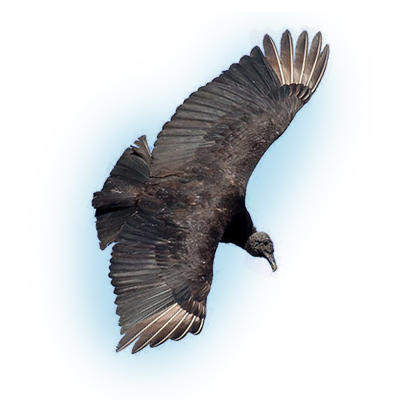A black vulture is one of the most familiar and recognizable birds throughout its range. They are large, have all-black plumage, and nearly always move about in flocks. Black vultures are often seen alongside roads and gather in large roost sites.

- A black vulture’s plumage is all black
- The tail is short and square
- Its wings are wide with silver patches on the tips
- The legs are long and gray but look whitish
- Its head is unfeathered with deep wrinkles
- It is usually seen in flocks
- Black vultures are quite
- It is the largest black bird in urban areas
What does a black vulture look like perched?
A black vulture perched is easily identified by its all-black plumage, large size, short tail, and relatively long legs that look whitish at first.
Adult black vultures have featherless heads with deep wrinkles. The unfeathered head extends to the upper neck. The bill is relatively long and narrow.

Size of a black vulture
Black vultures are large black birds. They have a bulky body that is smaller than a bald eagle but larger and bulkier than a hawk.
Identification of male and female black vulture
Black vultures are monomorphic, which means they have the same plumage in both sexes.
Unlike birds of prey, male and female black vultures have similar sizes.
Measurements
| Length | Weight | Wingspan (male and female) |
| 22 – 29 inches 1.8 – 2.4 ft | 4.4 – 5 lb 70.5 – 80ab oz | 54 – 60 inches 4.4 – 5.5 ft |
What does a black vulture look like in flight?
In flight, a black vulture looks superficially like a bat. The broad wings and short tail gives the vulture a silhouette that shows a rounded trailing side.
When flying close to the ground, above trees, and on overcast days, black vultures do so with fast and heavy wing beats interspersed with short glides. During the warm parts of the day, they are more likely to be seen soaring with their wings spread out in flocks of varying sizes.

Seen from below, a black vulture looks all black with a distinctive silvery or gray patch on the wingtips. These patches are made up of the outer primary flight feathers.
Bare parts
The beak is relatively long and narrow, with a hook at the tip. Generally, adult birds have a black bill with a beige or gray tip that varies in tone among individuals.
Young birds start with an entirely black beak that turns pale at the tip when the bird reaches adulthood in four years.
Older birds have more extensive unfeathered wrinkled heads than younger birds. The wrinkled skin in these birds often extends to the upper to mid-neck.
The bare head of juvenile black vultures is restricted and has shallow wrinkling. As young birds age, the bare area expands and becomes progressively more wrinkled.
Young black vultures reach sexual maturity and adulthood in about four years.
Black vulture legs are brown but look whitish
The black vulture’s legs are brown, but they appear whitish since it deliberately defecates its whitish poop onto its legs. Vultures poop on their legs for two reasons.
- First, birds do so as a way to release heat and keep cool. In order for water molecules to transform from a liquid to a gaseous state, they must first absorb heat energy. In this way, when birds defecate on their legs, the viscous liquid poop evaporates and dries, absorbing heat from the bird’s legs. Vultures’ black plumage absorbs more heat than light-colored plumages.
- Black vultures may also use their own poop as an antiseptic. Vultures have strong digestive juices that kill bacteria in their food. Their poop also contains antibacterial juices that serve as an antiseptic to keep their legs clean from the bacteria they collect from surfaces they walk on.
Identification of juvenile and adult black vultures
Juvenile and adult black vultures are very similar in plumage and general appearance. From distance, it can be difficult to discern differences.
At close range, juvenile birds show a dull black plumage in contrast to the somewhat glossy plumage of the adults.
The black plumage is the same in juveniles, males, and females birds and does not change with seasons or breeding status.
The most obvious difference between adult and juvenile black vultures is their head appearances.

Adult black vulture
- Adult black vultures have a black bill with a pale tip.
- The unfeathered area of the head is more extensive, gray in color, and more deeply wrinkled.
- The iris is reddish-brown

Juvenile black vulture
- Juvenile black vultures have an entirely black bill.
- The unfeathered area on the head is reduced, dark, and has a shallow wrinkling.
- Young vultures may retain some down for weeks after fledging.
Similar birds
Birds that also occur in the black vulture’s range and are likely to be seen together include:
Turkey Vultures, Bald Eagle, Crows, and red-tailed hawks.
Types/subspecies of black vultures
There are three types or subspecies of black vultures, all of which look alike except for minor variations in size and plumage. Throughout the species range, ornithologists recognize black vultures as follows:
- Black vultures of North America (Coragyps atratus atratus). Originally described by Bechstein, (1793), this subspecies occurs in North America, south to northern Mexico.
- Black vultures of Mexico, Central, and South America, and the Caribbean Basin (Coragyps atratus brasiliensis). First described by Bonaparte, (1850), this subspecies is the most numerous and widespread. It ranges in most thought the lowlands of South America.
- Andean Black Vulture (Coragyps atratus foetens). Described by M. H. C. Lichtenstein, (1817), this subspecies occurs in the Andes of South America from Northern Ecuador, through Peru, Northern Bolivia, and the lowlands of Southern Chile.